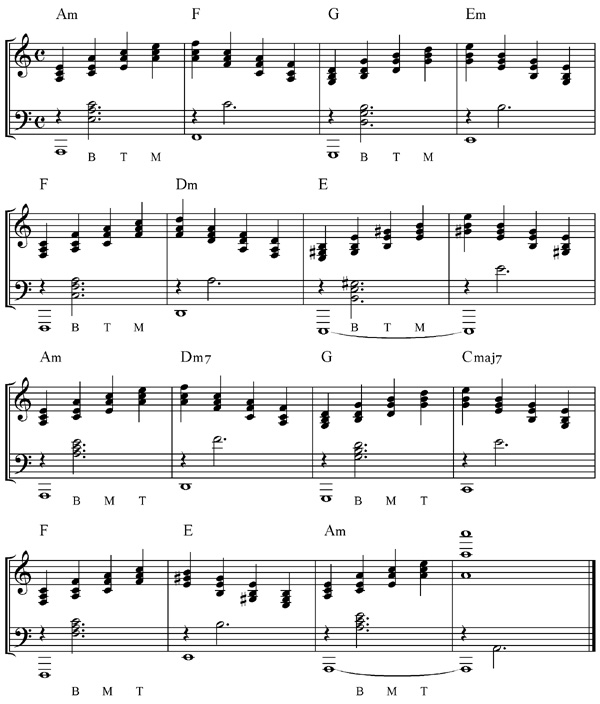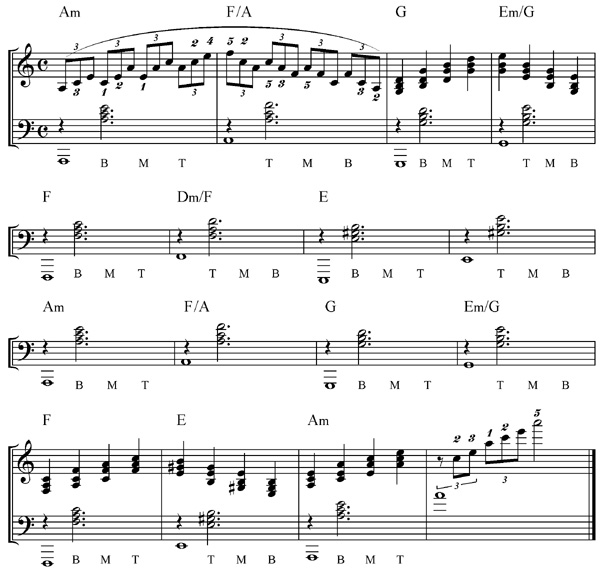The Pyramids Variations
Broken Chord Variations
TPV Diaries 14-11-12
TPV Diaries 14-11-12 is a broken chord study on the Pyramids Variations A1A2 chord sequence, with a couple of circle-of-fifths chords in the A2 stretch.

Watch it on MisterMusicarta YouTube
Here's the audio performance.
In classical piano, ‘broken chords’ usually means the hand climbing up or down the inversions of the triad, as the right hand does here. (See MS above, and watch the MidiPiano performance in the video.)
You can see the triads clearly in the skeleton music on the next page.
Classical pianists play lots of these patterns to familiarize the hand with the keyboard and train their 'ear'.
The trick is to ‘crawl’ the hand up (to the right) or down (to the left) so there are always fingers to play the notes to come. This means starting every new group of three notes (inversion) with the thumb going up and RH5 coming down.
A classical piano teacher would also expect to see the ‘official’ fingering for the inversions - RH1-3-5 for root position and second inversion and 1-2-5 for the first inversion, except at the top and bottom where the turn-around requires adaptation.
Patterns
Always look for the patterns. It’s easier and more creative to identify and play the pattern than the succession of notes it generates.
- The right hand starts in root position, rises three inversions (back to root position), then the top note goes up one note to make the next chord, and falls three inversions (except bars 7 and 8 and the ending).
Here are the right hand inversions as block chords.
Here are the right hand broken chords.
- The left hand plays a bass note - broken triad - bass note - single note pattern right through the piece. Practice the left hand on its own, block chords and broken.
- In the first half of the piece (A1), the left hand broken triad plays bottom - top - middle notes (B - T - M). (The BMT analysis is shown in the MS.)
- In the second half of the piece (A2), the left hand broken triad plays bottom - middle – top notes (B - M - T).
- The second half of the piece uses circle of fifths substitution chords Dm7 and Cmaj7. Only the bass note changes – it drops a third. The right hand chord stays the same (F, Em) as in the first eight bars.
Practice hands separately and together from the skeleton music as per the audio performances. Work towards keeping up!
The skeleton music here can’t be played as written – the hands overlap. It’s to show the ‘elements’ the study is made up of.

Watch the analysis video to see how the elements of the skeleton music become the study.
Watch it MisterMusicarta YouTube
Variation One: TPVD 15-03-13
You can easily devise other patterns to adhere to. Every new one you play makes you more and more the master of the music, rather than just the performer.
The TPVD 15-03-13 right hand is the same as 14-11-12. The underlying LH bass-plus-chords are shown in the skeleton music below. There are a lot of slash chords.
Watch it on MisterMusicarta YouTube

You cannot play the skeleton music as written because the hands compete for the same notes. Use it, along with the audio/MIDI performances and files to guide your build-up.
Remind yourself of the root position/first inversion left hand chord string.
Practice the slash-chord bass/left hand chord string as fast as you accurately can.
The left hand chords are broken up B-M-T then T-M-B, i.e., going up then going down. You do not need any fancy fingering; use 5-3-1/1-3-5 every time.
This is how to practice methodically - and methodical practice will always get you there.
Go straight on to Broken Chord Variations page 2 for more ways of making music out of these elements.
|
OUT NOW! |
THE MUSICARTA BEAT & RHYTHM WORKBOOK At last! An effective approach to keyboard rhythm & syncopation skills. Learn more! |
ONLY $24.95! |
PYRAMIDS |